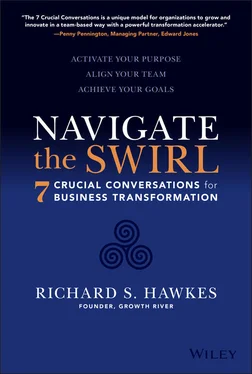I can't tell you that the journey will be easy. Transformational journeys aren't like that—at least not when they involve human beings. They offer too much to be proffered for so little. This journey will involve real work—reflective moments, honest conversations, hard-won insights, and difficult choices. It will include making important distinctions about team, business, and organizational life. And it will require courageous leadership.
If you're holding this book in your hands, I will consider you a leader, whether your job title confers that role officially or not. Anyone can be a leader on this transformational journey. Wherever you sit in your organization's system of roles, you have the opportunity to use the language, tools, and ideas in this book to create greater alignment and growth among your team. Whether that team is a small functional team responsible for a specific task or an executive team steering the company, its transformation will inspire and catalyze higher potentials in other teams. As teams become high performing, the organization becomes high performing. And as the organization becomes high performing, so, too, do its business models.
So, are you ready to break free of the Swirl? If you're failing, do you want to understand why, so you can change course? If you're succeeding, do you want to know how and be able to accelerate that success? If you're in a fast-changing industry, do you want to get ahead of the trends? If your old ways of doing things no longer work, are you open to trying something new? If you're moving fast, wouldn't you like to be sure you're headed in the right direction? If you're feeling stuck, are you ready to break free? There's never been a better moment to launch your team, your organization, and your business on the river of growth and transformation.
PART 1 Framing the Conversation
Organization. Business. Growth. Transformation. If you've picked up this book, there's a very good chance that those words mean something to you. But what exactly do they mean? Have you ever stopped to think deeply about what those terms represent? And do they mean the same thing to you as they do to the other people you're working with? If you want to embark on a transformational journey together—to engage in crucial conversations that will carry you forward—it's essential to be aligned around the core concepts, frameworks, and ideas that will shape that journey.
What is an organization? What is a business? And what does it mean for organizations and businesses to grow and transform? Each of these questions opens up a rich set of meanings, metaphors, and models that can help a team or an organization get on the same page about what they are a part of and where they are going. These are questions to which I've given a great deal of thought and consideration. The Growth River Operating System and the Seven Crucial Conversations are all built upon a specific way of thinking about organizations, a unique model for understanding businesses, and a particular perspective on how they grow and develop. Understanding these foundational concepts will set the stage for the journey and frame the conversations to come.
Language is foundational, which is why I spend so much time in this book defining terms and explaining foundational ideas. The terms, models, and metaphors that we use to visualize systems and situations have a profound impact on how we approach them. They shape our expectations of what's possible and the solutions available to us. Languages are the building blocks of human systems, and our ability to collaborate and organize in sophisticated ways around a shared purpose depends entirely upon our ability to communicate. I always say, organizations evolve at the speed of conversation, but we can't even have a conversation—let alone engage deeply in crucial conversations that lead to transformation—if we don't speak the same language. And too often, we may think we're speaking the same language, but actually have very different ideas about what the words we're using mean. That's a major contributor to the frustrating experience of the Swirl.
Throughout this book, you'll see the Growth River definitions of terms called out, with precise interpretations of words and phrases you may never have stopped to think closely about before. (A compendium of terms is also included in the Glossary.) But certain foundational ideas require deeper consideration and discussion: Organization. Business. Growth. Transformation. That's what we'll be doing in this part of the book. As leaders take the time to be more deliberate about how they use these terms, they bring much-needed clarity and direction to the organization's journey, creating a shared narrative. As team members begin to have a truly common language that describes their interactions and endeavors, as well as revealing new possibilities, they find themselves more easily able to align around their shared purpose and direction. So let's take the time to ask these questions: What is an organization? What is a business? And what does it mean for organizations and businesses to grow and transform?
CHAPTER 1 Understanding Organizations: Social Systems, Not Machines
A company is a multidimensional system capable of growth, expansion, and self-regulation. It is, therefore, not a thing but a set of interacting forces. Any theory of organization must be capable of reflecting a company's many facets, its dynamism, and its basic orderliness. When company organization is reviewed, or when reorganizing a company, it must be looked upon as a whole, as a total system .
—Albert Low Zen and Creative Management
“If you to want truly to understand something, try to change it,” the psychologist and organizational development pioneer Kurt Lewin is said to have declared. Over the course of the past few decades, my colleagues and I have tried to change numerous organizations—from small startups to well-established mid-sized businesses to massive multinational enterprises.
In the process, I have indeed come to understand a thing or two about these strange beasts. It's not the most elegant way to learn, especially when starting out, since the true nature of an entity is often revealed as it resists efforts at transformation. It's only when you start trying to move the pieces that you see how they're all connected, what keeps them in place, and what animates them. And more often than not, what you discover forces you to rethink your approach. I'm still learning, to this day, but what I can say with confidence is that the more I've learned about what an organization is, the more effective I've become as an agent of change. It is my hope that this learned knowledge may enable me to reverse that quotation for my readers and help you to avoid at least some of the trial and error. If you want to truly change something, try to understand it first . Otherwise, you won't get very far. At this point in this book, I invite you to pause and consider the question, What is an organization?
Many leaders think an organization is just a business, and their job is simply to run it. If only it were so simple. In fact, the strictly “business” part of an enterprise—the shared work we do to develop, sell, and deliver a product or service to customers—is only part of the endeavor. (That doesn't mean it's not critical—we'll come back to this definition of a business and how to optimize it in Chapter 2, when we introduce the Business Triangle®.) If you're a one-person company doing everything yourself, the business may be all you need to focus on. But the minute you want to grow or scale your company, you have to do something else. You have to deal with people. You must persuade people to join you and motivate them to come along on the journey with you. You must figure out how to inspire people to cooperate, to collaborate, and to become leaders in their own right. And, newsflash: people can be messy, complicated, and difficult—especially when you're dealing with groups of them. There is no getting around this truth.
Читать дальше












